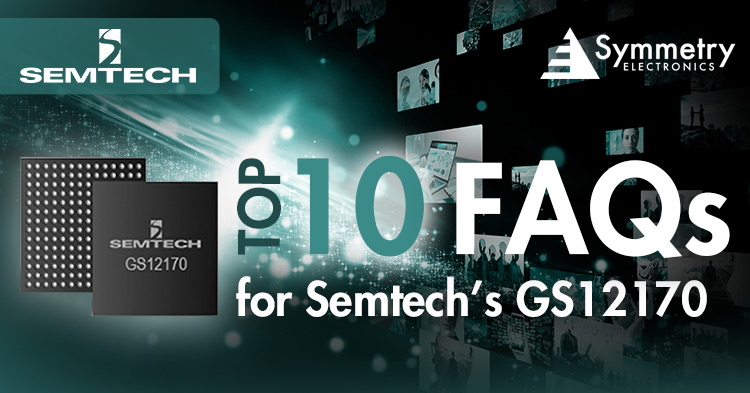- Home
- Symmetry Blog
- Top 10 FAQ for Semtech’s GS12170 SDI/HDMI Bridge
Top 10 FAQ for Semtech’s GS12170 SDI/HDMI Bridge
About Ray Pan

1. Does Semtech’s GS12170 SDI/HDMI Bridge ASIC support High-Bandwidth Digital Content Protection (HDCP) encryption and description for HDMI input/output?
No, the GS12170 supports unencrypted Transition-Minimized Differential Signaling (TMDS) inputs/output encoded in accordance with HDMI 1.4b and HDMI 2.0 specifications.
2. Does the GS12170 bridge support AC3 compressed audio?
Yes, Semtech’s GS12170 can support AC3 Dolby Digital through AES/EBU audio interface.
3. Does GS12170 support Audio De-embedding and Embedding for serial input/output?
Yes, the GS12170 can handle up to 16-channels of Audio Embedding and De-embedding. It should be noted that the GS12170 will bypass the audio processing core. The GS12170 cannot support these audio functions in bypass mode.
4. Is a Generic Serial Peripheral Interface (GSPI) communication port required for GS12170 applications?
A GSPI is required for certain features like Ancillary Data (ANC) handling. A GSPI is strongly recommended for 12G UHD-SDI devices to facilitate dynamic system configuration and tuning.
5. Is an HDMI Retimer mandatory to support HDMI inputs for the GS12170?
The GS12170 is expecting HDMI 1.4a or HDMI 2.0 compliant unencrypted TMDS inputs. Additional information regarding DC/AC characteristics can be found in Semtech’s GS12170 SDI/HDMI Bridge data sheet. For applications featuring HDMI cable inputs, a retimer is strongly recommended. Improved signal integrity and compatibility vary with different HDMI source equipment.
6. Does the GS12170 need to be paired with a Cable Driver (CD) and Equalization (EQ) with Relocker?
Yes, a CD and EQ with Reclocker are recommended to ensure signal integrity and to meet Society of Motion Picture and Television Engineers (SMPTE) standards.
7. What are the recommended companion EQs and CDs that accommodate 12G SDI input and output for the GS12170?
SDI Cable Driver:
- For BNC output (75ohm): GS12281/GS12182/GS12190 for 12G/6G, GS2994/GS2993 for 3G/HD applications
- For Optical output (SFP: 100ohm diff): GS12150/GS12190 for 12G/6G, GS6151/GS6152 for 6G/3G applications
SDI Equalizer:
8. Are the GS12170 differential serial inputs/outputs DC or AC coupled?
The differential serial inputs/outputs must be AC-coupled.
9. Does the GS12170 support VESA display mode?
The GS12170 cannot support VESA PC formats.
10. Is the external Phase-Locked Loop (PLL) that is included in the GS12170 Reference Design Kit (RDK) required for operation?
While not required, the external PLL is recommended when operating the GS12170 in HDMI to SDI mode to help clean any excessive jittering from the external source. The GS12170 Reference Design Kit is offered in an HDMI-to-SDI (RDK-GS12170-H2S00) or SDI-HDMI (RDK-GS12170-S2H00) variant.
Semtech, LoRa and the LoRa logo are registered trademarks or service marks, and LoRa Basics, LoRa Cloud and LoRa Edge are trademarks of service marks, of Semtech Corporation or its affiliates.




